JVC PD-42V31BUE, PD-42V31BJE, PD-42V31BSE User Manual
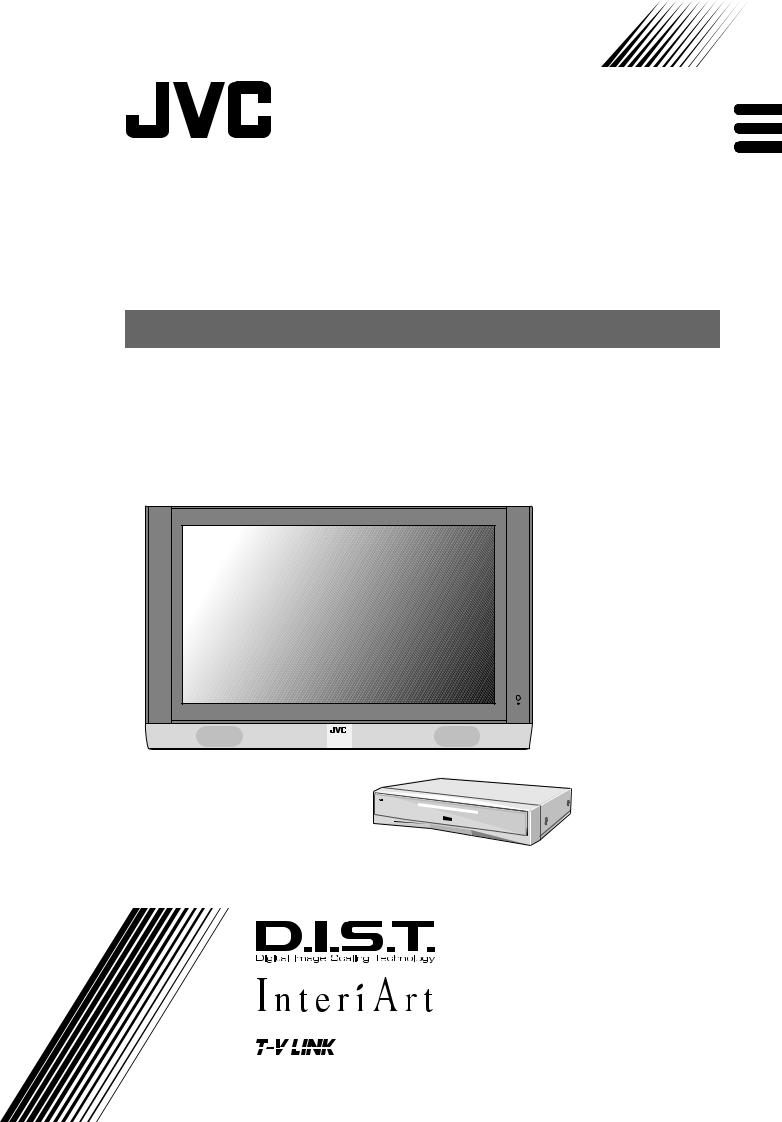
PD-42V31BUE PD-42V31BJE PD-42V31BSE
PDP COLOUR TELEVISION
PDP FARBFERNSEHGERÄT PDP TELEVISEUR COULEUR
ENGLISH
DEUTSCH
FRANÇAIS
INSTRUCTIONS
BEDIENUNGSANLEITUNG
MANUEL D’INSTRUCTIONS
1

Warning
DO NOT cut off the mains plug from this equipment. If the plug fitted is not suitable for the power points in your home or the cable is too short to reach a power point, then obtain an appropriate safety approved extension lead or adaptor or consult your dealer.
If nonetheless the mains plug is cut off, remove the fuse and dispose of the plug immediately, to avoid a possible shock hazard by inadvertent connection to the mains supply.
If a new mains plug has to be fitted, then follow the instruction given below:
Important
Do not make any connection to the larger terminal which is
marked with the letter E or by the safety earth symbol  or coloured green or green-and-yellow.
or coloured green or green-and-yellow.
The wires in the mains lead on this product are coloured in accordance with the following code:
Blue: Neutral
Brown: Live
As these colours may not correspond with the coloured marking identifying the terminals in your plug proceed as follows:
The wire which is coloured blue must be connected to the terminal which is marked with the letter N or coloured black.
The wire which is coloured brown must be connected to the terminal which is marked with the letter L or coloured red.
When replacing the fuse, use only a correctly rated approved type and always re-fit the fuse cover.
If in doubt — consult a competent electrician.
How to replace the fuse
Open the fuse compartment with a
blade screwdriver, and replace the
fuse.
 Fuse
Fuse
Guidelines for safe operation
This equipment has been designed and manufactured to comply with international safety standards. However, as with any electrical appliance, care must be taken to ensure optimal results and operational safety.
•Before attempting to use this equipment, read the operating instructions thoroughly.
•Ensure that all electrical connections (including the mains plug, extension leads, etc.) have been made in accordance with the manufacturer’s instructions.
•If ever in doubt about the installation, operation or safety of this equipment, consult your dealer.
•Handle all glass panels or covers with care.
•Never operate this equipment if it appears damaged or operates abnormally. Turn the power off, disconnect the main power plug and consult your dealer.
•Never remove any affixed panels or covers. Doing so may result in electrical shock.
•Never leave this equipment operating unattended unless otherwise specifically stated that it is designed to do so or in standby mode. Only use the designated power switch to turn off the power and ensure that all potential users are instructed how to do so. Make special arrangements for infirm or handicapped persons.
•Never watch TV while operating a motor vehicle. It is illegal to watch TV while driving.
•Never listen to headphones at high volume. Doing so may damage your hearing.
•Never obstruct the ventilation of this equipment. Doing so may cause overheating and result in a malfunction or damage.
•Never use makeshift stands or attempt to affix legs with wood screws. When using a manufacturer’s approved stand or legs, use only the fixtures provided and follow the installation instructions.
•Never allow this equipment to be exposed to rain or moisture.
•Never allow anyone, especially children, to insert anything into an opening in the case. Doing so may result in a fatal electrical shock.
•Never guess or take chances with electrical equipment of any kind. It is better to be safe than sorry.
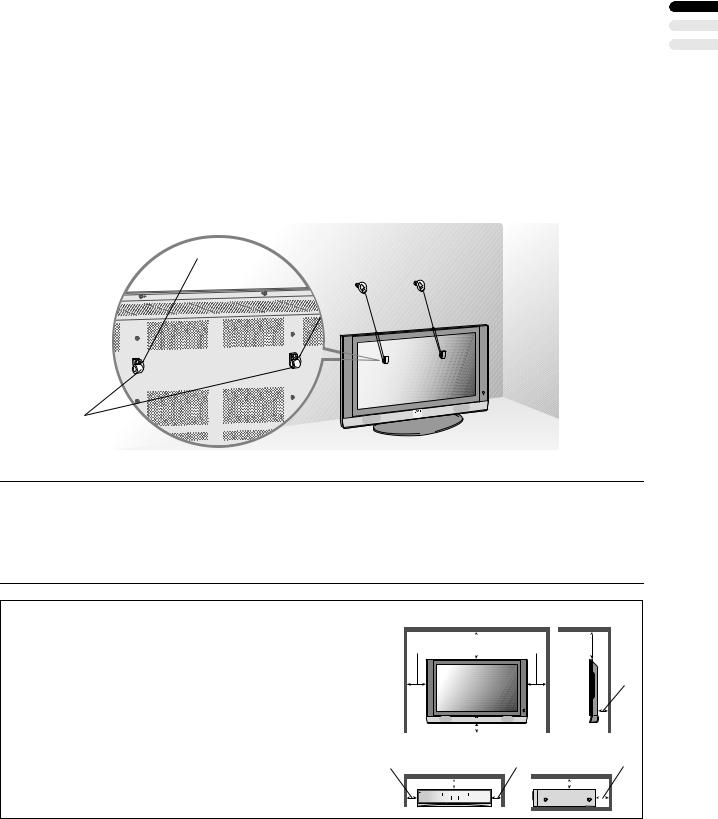
Thank you for buying this JVC colour television.
To make sure you understand how to use your new TV, please read this manual thoroughly before you begin.
WARNING: TO PREVENT FIRE OR SHOCK HAZARD, DO NOT EXPOSE THIS APPLIANCE TO RAIN OR MOISTURE.
WARNING
Always use the power cords which are supplied with the TV and receiver.
Some power cords are supplied with this TV. Use the power cord which best suits the area in which you live, and insert it into a correctly earthed outlet.
Failure to use the supplied power cord or to insert it into a correctly earthed outlet may result in electric shocks.
WARNING FOR TABLE TOP STAND:
To ensure safety in an emergency such as an earthquake, and to prevent accidents, ensure that measures are taken to prevent the TV dropping or falling over.
•Use the supplied screws to firmly attach the supplied hooks to the back of the TV, and use commercially available cord to fix the TV to rigid components such as walls and columns.
ENGLISH
Supplied hooks
CAUTION:
•Operate only from the power source specified (AC 110 – 240 V, 50/60 Hz) on the unit.
•Avoid damaging the AC plug and power cord.
•When you are not using this unit for a long period of time, it is recommended that you disconnect the power cord from the main outlet.
•The ambient temperature for using this unit is 0° to 40°C (32° to 104°F). Using the unit outside of this range may lead to it not working correctly or being broken.
Distance recommendations
Avoid improper installation and never position the unit where good ventilation is impossible.
When installing this TV, distance recommendations must be maintained between the set and the wall, as well as inside a tightly enclosed area or piece of furniture.
Keep to the minimum distance guidelines shown for safe operation.
|
200 mm |
200 mm |
|
150 mm |
150 mm |
||
|
|||
|
|
|
50 mm
|
|
|
|
|
|
|
|
|
|
|
50 mm |
|
|
|
|
|||||
|
|
|
|
|
|
|
|
|
|
|
|
|
|
|
||||||
|
|
|
|
|
|
|
|
|
|
|
|
|
|
|
||||||
|
|
|
|
|
|
|
|
|
|
|
|
|
|
|
100 mm |
|||||
100 mm |
|
|
|
100 mm |
|
|
|
|||||||||||||
|
|
|
|
|
|
|
|
100 mm |
|
|
|
|
|
|
100 mm |
|||||
|
|
|
|
|
|
|
|
|
|
|
|
|
||||||||
|
|
|
|
|
|
|
|
|
|
|
|
|
|
|
|
|
|
|
|
|
|
|
|
|
|
|
|
|
|
|
|
|
|
|
|
|
|
|
|
|
|
|
|
|
|
|
|
|
|
|
|
|
|
|
|
|
|
|
|
|
|
|
|
|
|
|
|
|
|
|
|
|
|
|
|
|
|
|
|
|
|
|
|
1

Burn-in
A characteristic of Plasma Display Panels (PDPs) is that displaying the same image for a long time causes a part of the image to stay on the screen (this is called phosphor burn-in).
Avoid burn-in as follows.
Use the PICTURE SHIFT function. To prevent burn-in, the picture displayed on the screen is shifted up, down and to the left and right at regular intervals. See page 30 for details.
• Even if the PICTURE SHIFT function is turned off, the picture may shift to the left or right when the channel or input is changed.
The PICTURE MODE function is initially set to BRIGHT. Unless the TV is being watched in an extremely bright room, it is recommended to change the PICTURE MODE setting to either STANDARD or SOFT. Doing so will reduce the chance of PDP burn-in and extend the life of the PDP. See “PICTURE MODE” on page 21
Do not display static images or characters for long periods of time.
While an image is displayed |
With power OFF |
19:03 |
19:03 |
Burn-in example |
|
• Reduce CONTRAST and BRIGHT on the PICTURE SETTING menu (page 21) when viewing.
Do not view for long periods of time in the REGULAR mode (page 15).
Screen size is normally chosen to ensure that the picture is displayed on the entire screen. After viewing in the REGULAR mode in which black bands may occur at the left and right of the screen, it is recommended to change to the PANORAMIC mode to display the picture on the entire screen.
While an image is displayed |
With power OFF |
Burn-in example
Do not view for long periods of time using the PIP function (page 16) or MULTI-PICTURE function (page 17).
If Burn-in has occurred
If burn-in occurs, try the REFRESH function (page 30). If burn-in is minimal it may gradually become less noticeable.
Note:Once burn-in occurs it will never disappear completely.
2
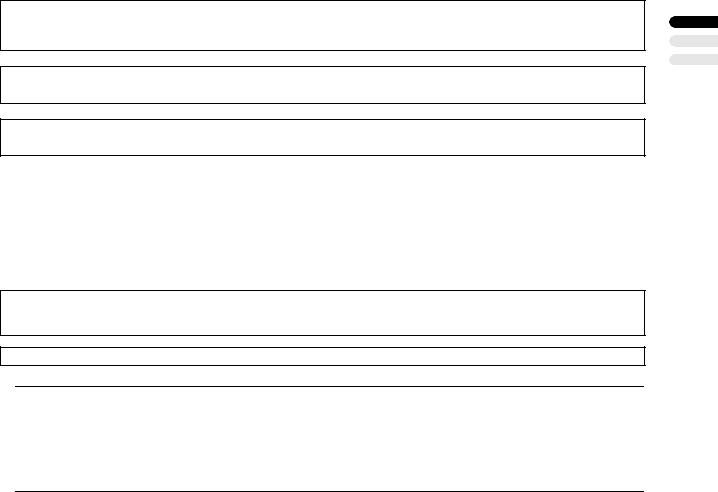
Pixel defects
PDPs use collections of fine dots (“pixels”) to display images. While there is no problem with more than 99.99% of these pixels, please understand that a very small number of pixels may not light, or may light all the time.
Do not install the TV near electronic equipment that is susceptible to electromagnetic waves
It may cause interference in images, sound, etc. In particular, keep video equipment away from this product.
Effect on infrared devices
There may be interference while using infrared devices such as infrared cordless headphones.
Failure to heed the following precautions may result in damage to the TV or remote control.
DO NOT block the TV’s ventilation openings or holes.
(If the ventilation openings or holes are blocked by a newspaper or cloth, etc., the heat may not be able to get out.)
DO NOT place anything on top of the TV.
(such as cosmetics or medicines, flower vases, potted plants, cups, etc.)
DO NOT allow objects or liquid into the cabinet openings.
(If water or liquid is allowed to enter this equipment, fire or electric shock may be caused.)
DO NOT place any naked flame sources, such as lighted candles, on the TV.
The surface of the TV screen is easily damaged. Be very careful with it when handling the TV.
Should the TV screen become soiled, wipe it with a soft dry cloth. Never rub it hard.
Never use any cleaner or detergent on it.
In the event of a fault, unplug the unit and call a service technician. Do not attempt to repair it yourself or remove the rear cover.
D.I.S.T. demonstration
To start the D.I.S.T. demonstration:
Press the abutton to display the MENU (main menu). Then press the yellow button.
A picture split in two (D.I.S.T. turned on and D.I.S.T. turned off) will appear on the screen.
To quit the D.I.S.T. demonstration:
Press the yellow button, bbutton, P pbuttons or any of the number buttons.
ENGLISH
3

CONTENTS
Checking contents of packages............ |
5 |
Setting up your TV.................................. |
6 |
Installation.......................................................... |
6 |
Putting the batteries into the Remote control..... |
6 |
Connections............................................ |
7 |
Connection diagram........................................... |
7 |
Connecting the TV and receiver ........................ |
8 |
Connecting the aerial and video cassette |
|
recorder (VCR)................................................... |
8 |
Connecting the power cord to the AC outlet ...... |
9 |
Initial settings ....................................... |
10 |
T-V LINK functions........................................... |
11 |
TV buttons and functions .................... |
12 |
Turn the TV on from standby mode ................. |
12 |
Choose a TV channel ...................................... |
12 |
Watch images from external devices ............... |
12 |
Adjust the volume ............................................ |
12 |
Using the headphone....................................... |
12 |
Using the Menu................................................ |
12 |
Remote control buttons and |
|
functions............................................ |
13 |
Turn the TV on or off from standby mode ........ |
13 |
Choose a TV channel ...................................... |
13 |
Adjust the volume ............................................ |
14 |
Watch images from external equipment .......... |
14 |
ZOOM function................................................. |
15 |
3D SOUND function......................................... |
15 |
Displaying the current time .............................. |
16 |
Return to TV channel instantly......................... |
16 |
Using the FREEZE function ............................. |
16 |
Using the PIP function ..................................... |
16 |
Using the MULTI-PICTURE function ............... |
17 |
Operating a JVC brand VCR or DVD player .... |
17 |
Teletext function................................... |
18 |
Basic operation ................................................ |
18 |
Using the List Mode ......................................... |
18 |
Hold.................................................................. |
18 |
Sub-page ......................................................... |
19 |
Reveal.............................................................. |
19 |
Size .................................................................. |
19 |
Index ................................................................ |
19 |
Cancel.............................................................. |
19 |
Using the TV’s menu............................ |
20 |
Basic operation ................................................ |
20 |
PICTURE SETTING ............................... |
21 |
PICTURE MODE ............................................. |
21 |
Picture Adjustment........................................... |
21 |
COLOUR TEMP............................................... |
21 |
PICTURE FEATURES........................... |
22 |
DIGITAL VNR.................................................. |
22 |
Super DigiPure................................................ |
22 |
COLOUR SYSTEM ......................................... |
23 |
MOVIE THEATRE........................................... |
23 |
4:3 AUTO ASPECT......................................... |
23 |
COLOUR MANAGEMENT .............................. |
23 |
PIP (picture-in-picture) .................................... |
24 |
SOUND SETTING ................................. |
25 |
STEREO / I • II ................................................ |
25 |
Sound Adjustment........................................... |
25 |
SPEAKER ....................................................... |
25 |
BBE ................................................................. |
25 |
3D SOUND...................................................... |
25 |
A.H.B. (Active Hyper Bass) ............................. |
25 |
HEADPHONE ................................................. |
26 |
EXT SETTING ....................................... |
27 |
S-IN (S-VIDEO input) ...................................... |
27 |
ID LIST ............................................................ |
27 |
DUBBING........................................................ |
27 |
FEATURES............................................ |
29 |
SLEEP TIMER ................................................ |
29 |
BLUE BACK .................................................... |
29 |
CHILD LOCK................................................... |
29 |
DECODER (EXT-2)......................................... |
30 |
REFRESH ....................................................... |
30 |
PICTURE SHIFT ............................................. |
30 |
INSTALL................................................ |
31 |
LANGUAGE .................................................... |
31 |
AUTO PROGRAM........................................... |
31 |
EDIT/MANUAL ................................................ |
32 |
Additional menu operations ............... |
35 |
Using the ACI function .................................... |
35 |
Downloading data to a VCR............................ |
35 |
Changing the COUNTRY setting .................... |
36 |
Using the DECODER (EXT-2) function........... |
36 |
Additional preparation......................... |
37 |
Connecting external equipment ...................... |
37 |
CH/CC numbers ................................... |
39 |
Troubleshooting................................... |
40 |
Specifications....................................... |
42 |
4
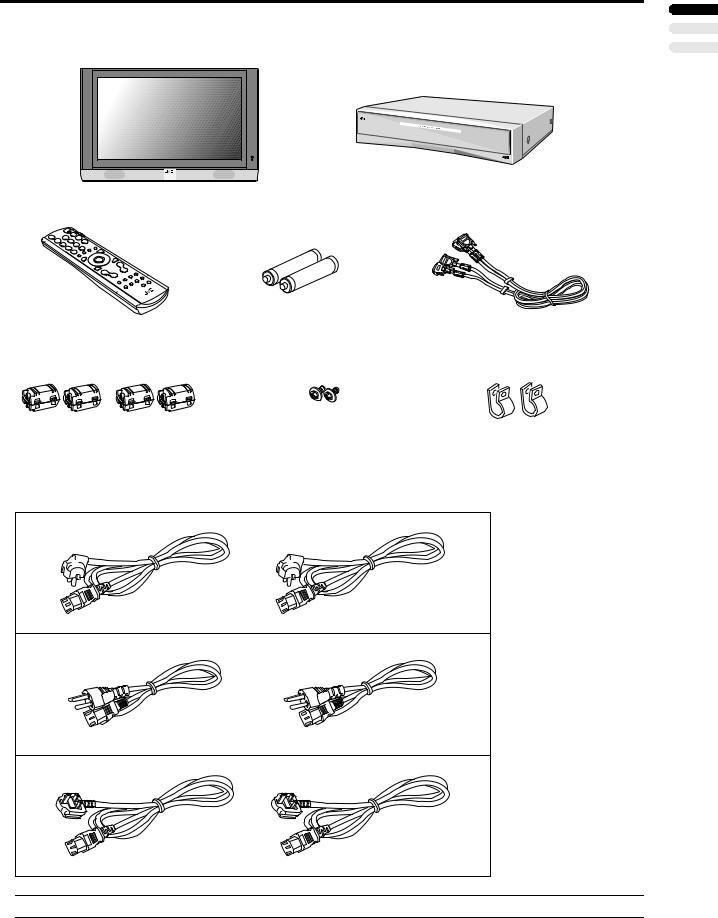
Checking contents of packages
Check that all components are present. Contact your retailer immediately if any components are missing.
Receiver
TV
Remote control |
AA/R6-size batteries |
(used to check operation) |
Ferrite core × 4 |
Mounting screw × 2 |
|
Power cord
• One of the power cords below, suitable for your area, will be included with your TV.
System cable
Hook × 2
• Some models come with a stand or wall-mounting fixtures.
ENGLISH
5

Setting up your TV
Be sure to have someone help you when you lift up the TV. The TV is too heavy to lift up by yourself. If the TV falls, it will cause injuries and damage.
Installation
Depending on the model, the TV may come with a wall mounting unit or table top stand. If so, a separate instruction manual is provided. Read that instruction manual and install the TV correctly.
•For models which are supplied without a wall mounting unit or table top stand, or when using another unit to install the TV, only use JVC units which were designed for this TV.
Warning for wall mounting unit:
•Use only authorized service personnel to install your TV in order to prevent accidents. Do not try to install your TV by yourself.
•We sell this product on the understanding that it will be assembled and installed by qualified service personnel.
•Please read the instruction manual for the wall mounting unit before starting installation in order to prevent accidents.
•We are not liable for any damage caused by faulty assembly, faulty wall mounting, insecure wall mounting, misuse, alterations, or natural disasters.
Cautions for installation
•Do not tilt the TV towards the left or right, or towards the back.
•Install the TV in a corner on a wall or on the floor so as to keep cords out of the way.
•The TV will generate a slight amount of heat during operation. Ensure that sufficient space is available around the TV to allow satisfactory cooling. See “Distance recommendations” on page 1
Putting the batteries into the Remote control
Use two AA/R6 dry cell batteries.
Insert the batteries from the - end, making sure the + and - polarities are correct.
•Follow the warnings printed on the batteries.
•Battery life is about six months to one year, depending on your frequency of use.
•The batteries we supply are only for setting up and testing your TV, please replace them as soon as you need to.
•If the remote control does not work properly, replace the batteries.
6
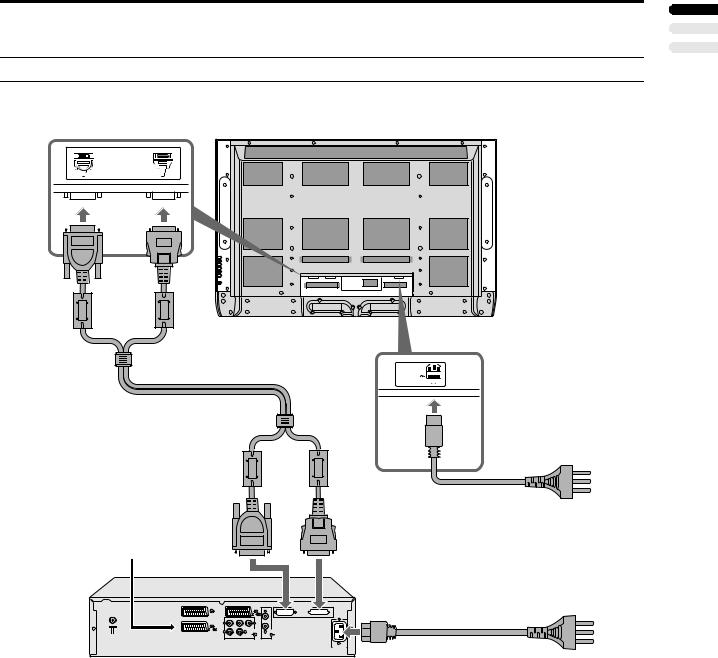
Connections
Caution
• Turn off all equipment including the TV before connecting anything.
Connection diagram
TV (back)
DISPLAY INPUT
CONNECT TO SYSTEM CABLE
AC INPUT 110-240V
Supplied system cable
Cable supplied with TV
• Refer to page 9 for connection details.
Connecting antenna and other equipment
• Refer to page 8 for connection details.
EXT-1 |
EXT-3 |
DISPLAY OUT |
|
S |
L |
|
|
|
EXT-2 |
|
R |
Pr |
Pb Y |
|
S |
EXT-4 |
AUDIO OUT |
|
||
R |
L |
|
|
|
AC110-240V |
Receiver (back) |
Cable supplied with receiver |
|
• Refer to page 9 for connection details. |
||
ENGLISH
7
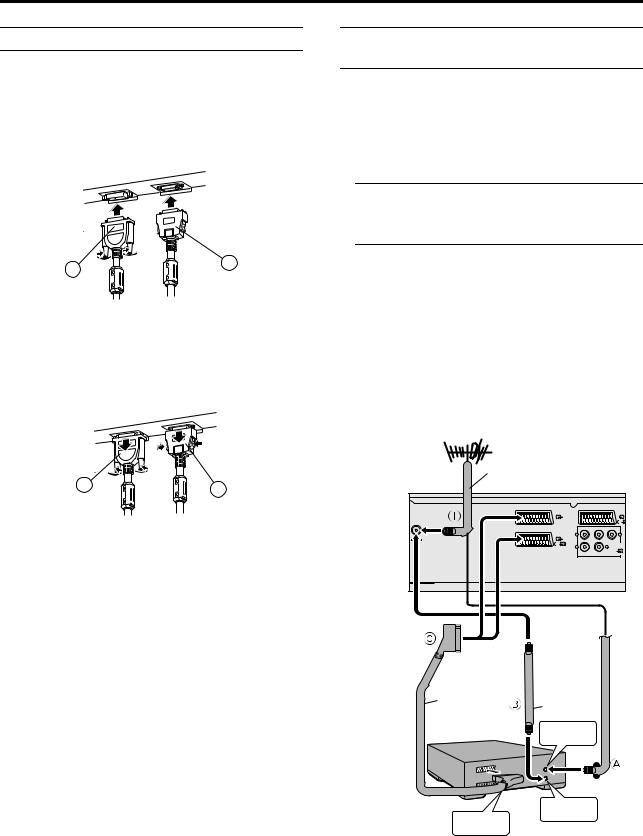
Connections
Connecting the TV and receiver
Use the supplied system cable to connect the TV to the receiver.
The two connectors are of different shapes.
Ensure that the pins on connector 1 are oriented correctly, press the connector into the socket, and tighten the screws at left and right to lock it in place.
Press connector 2 firmly into place until it is locked.
1 |
2 |
|
Disconnecting the system cable
Release connector 1 by unscrewing the screws at left and right and removing it from the socket.
Release connector 2 by removing it from the socket while pressing the release bottoms on either side.
1 |
2 |
|
Connecting the aerial and video cassette recorder (VCR)
•The connecting cables are not provided.
•For further details, refer to the manuals provided with the devices to be connected.
If you are connecting a VCR, follow A → B → C in the diagram opposite.
If you are not connecting a VCR, follow 1.
To use the T-V LINK functions, you must have a T-V LINK compatible VCR connected by a SCART cable C to the EXT-2 terminal on the TV. For details about T-V LINK functions, see “T-V LINK functions” on page 11.
•You can watch a video using the VCR without doing C. For details, see your VCR instruction manual.
•To connect more equipment, please see “Connecting external equipment” on page 37.
•To connect additional audio equipment, see “Connecting Speakers/Amplifier” on page 38.
•If you connect a decoder to a T-V LINK compatible VCR, set the DECODER (EXT-2) function to ON. For details, see “Using the DECODER (EXT-2) function” on page 36.
Otherwise, you will not be able to watch scrambled channels.
Aerial
75-ohm Coaxial Cable
Back of the receiver
EXT-1 |
|
EXT- |
|
|
S |
EXT-2 |
|
|
Pr |
Pb |
Y |
S |
|
EXT-4 |
|
|
|
R |
L |
|
21-pin |
75-ohm |
Coaxial |
|
SCART |
Cable |
Cable |
|
VCR |
To Aerial |
Input |
To Aerial
AV IN/OUT Output
Terminal
8

Connections
|
Receiver (back) |
|
Connecting the power cord to the AC |
||
|
||
outlet |
|
|
Insert the AC plugs on the power cords from the TV and |
|
|
receiver into AC outlets. |
|
|
Caution |
|
• Operate only from the power source specified (AC 110
– 240 V, 50/60 Hz) on the unit.
• Failure to use the supplied power cord or to insert it into a correctly earthed outlet may result in electric shocks.
EXT-1 |
EXT-3 |
DISPLAY OUT |
|
S |
L |
|
|
|
EXT-2 |
|
R |
Pr |
Pb Y |
|
S |
EXT-4 |
AUDIO OUT |
|
||
R |
L |
|
AC110-240V
Use the supplied power cord which best suits the area in which you live.
Attaching the ferrite cores
Attach ferrite cores to the power cord.
Using the power cord without ferrite cores may lead to noise (interference).
Open the ferrite core, insert the power cord and close the ferrite core.
Attach a ferrite core to each end of the power cord.
Ferrite core
Power cord
1 Aerial socket (page 8)
2 EXT-1 terminal (pages 8, 27, 37)
3 EXT-2 terminal (pages 8, 11, 27, 37) 4 EXT-3 terminal (pages 27, 37)
5 EXT-4 terminal (pages 27, 37)
6 AUDIO OUT terminal (page 38)
7 DISPLAY OUT terminal (page 8)
8 AC INLET (page 9)
Supplied ferrite cores
Supplied ferrite cores
Supplied ferrite cores
Back of the TV |
AC INLET |
Power cord |
|
AC INLET |
|
|
AC110-240V |
Power cord |
Back of the receiver |
|
ENGLISH
Insert the AC plug into a correctly earthed outlet.
The receiver power lamp lights red, and the receiver is in the standby mode, when the AC plug on the power cord is connected to an AC outlet.
•Remove the AC plug from the outlet to completely disconnect the TV from the power supply.
9
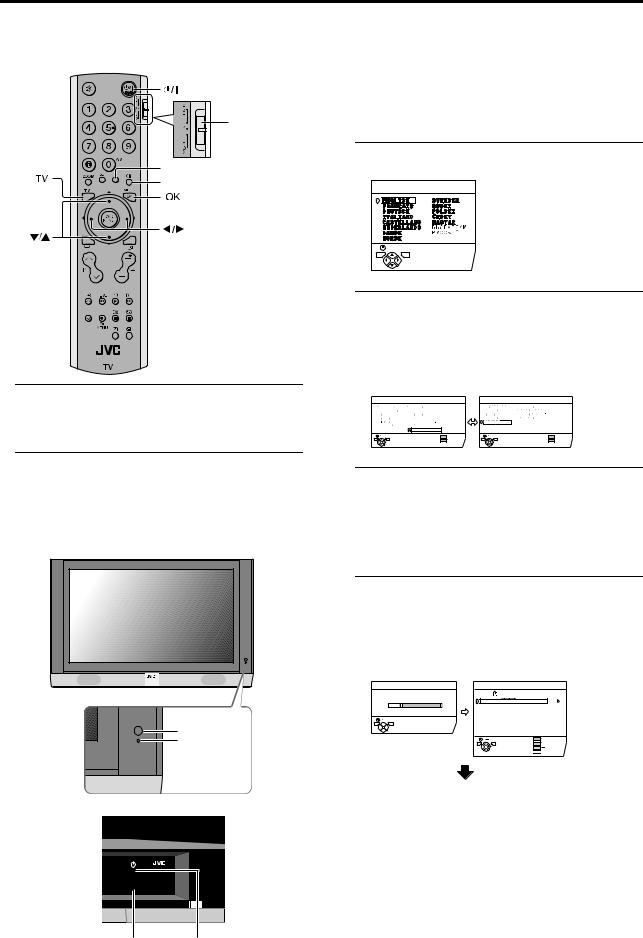
Initial settings
When the TV is first turned on, it enters the initial setting mode, and the JVC logo is displayed. Follow the instructions on the on-screen display to make the initial settings.
VCR/TV/DVD |
Switch |
Yellow button |
Blue button |
1Make sure you set the VCR/TV/DVD switch to the TV position.
•You cannot turn the TV on when the VCR/TV/DVD switch is set to the VCR or DVD position.
2Press the #button on the remote control
The receiver power lamp changes from red to green. After a short interval the TV power lamp lights green and the JVC logo is displayed.
•Check that the AC plugs on the power cords from the TV and receiver are connected to AC outlets.
TV (front)
Remote control |
sensor |
Power lamp |
Receiver (front)
A button |
Power lamp |
•If the power lamp stays red and does not change to
green:
Your TV is in the standby mode. Press the # (Standby) button again to turn your TV on.
•If the JVC logo does not appear this is because your TV has already been turned on for the first time: use the “LANGUAGE” and “AUTO PROGRAM” functions to make the initial settings. For details, see “INSTALL” on page 31.
3Press the abutton
The LANGUAGE menu appears.
LANGUAGE
 BACK
BACK
TV OK
D0002(E)-EN
4Press the 5and 6buttons to choose ENGLISH. Then press the abutton
The on-screen display will then be in English.
The COUNTRY menu appears as a sub-menu of the AUTO PROGRAM function.
There are two COUNTRY menus. Pressing the yellow button changes the COUNTRY menu as follows:
|
BACK |
START |
|
BACK |
START |
TV |
OK |
MORE |
TV |
OK |
MORE |
D0003-EN
5Press the 5and 6buttons to choose the country where you are
•For uses in the UK:
To receive SKY 1 you need a satellite tuner. You must have the satellite tuner set to SKY 1 before starting the AUTO PROGRAM function which follows.
6Press the blue button to start the AUTO PROGRAM function
The AUTO PROGRAM menu appears and received TV channels are automatically stored in the programme numbers (PR).
•To cancel the AUTO PROGRAM function: Press the bbutton.
AUTO PROGRAM |
EDIT |
|
|
|
|
|
CH 10 |
PR |
ID |
CH / CC |
|
|
AV |
|
|
|
|
|
|
01 |
BBC1 |
CH |
21 |
|
20% |
02 |
|
CH |
22 |
|
|
03 |
|
CH |
23 |
|
|
04 |
|
CH |
24 |
|
BACK |
05 |
|
CH |
25 |
|
06 |
|
CH |
26 |
|
TV |
OK |
07 |
|
CC |
01 |
|
|
08 |
|
CC |
02 |
|
|
09 |
|
CC |
03 |
|
BACK |
ID |
TV |
OK |
INSERT |
|
MOVE |
DELETE |


 MANUAL
MANUAL
D0004-EN
After the TV channels have been registered in the programme numbers (PR), the EDIT menu appears
•If you want to, you can now edit the programme numbers (PR) using the EDIT/MANUAL function. For details, see “EDIT/MANUAL” on page 32.
•If you do not want to edit programme numbers (PR), go to the next step.
10
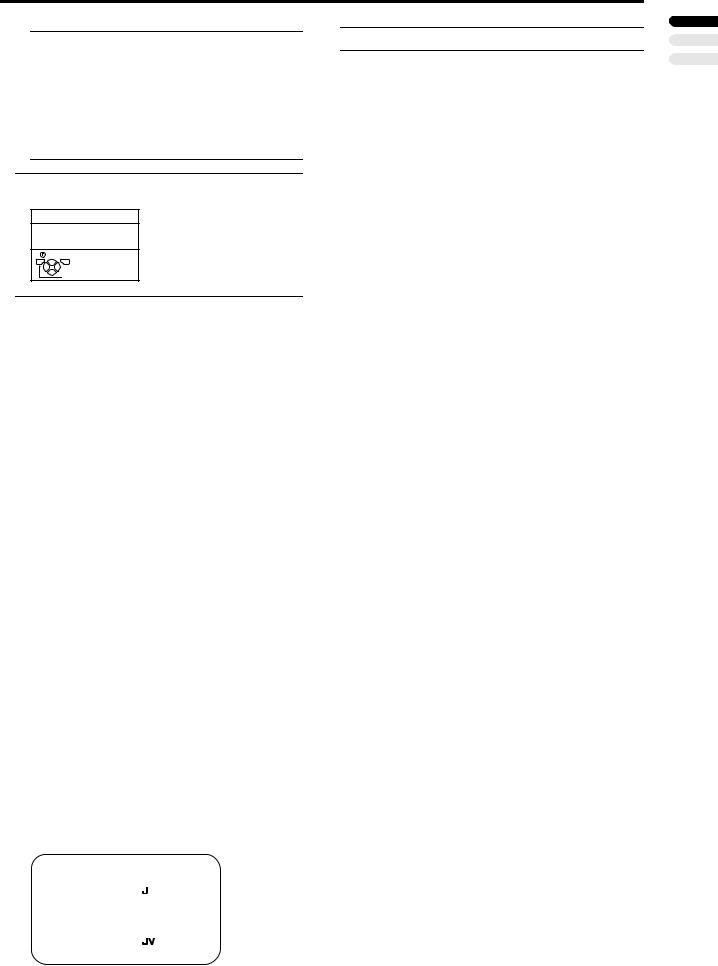
Initial settings
If “ACI START/ACI SKIP” appears in the AUTO PROGRAM menu:
You can use the ACI (Automatic Channel Installation) function to decode the ACI data and complete the registration of all the TV channels quickly. For details of the ACI function and how to use it, see “Using the ACI function” on page 35.
If you don’t want to use the ACI function, press the 6 buttons to choose ACI SKIP and then press a.
7Press the abutton to display the T-V LINK menu
T-V LINK
DOWNLOAD TV  VCR
VCR
 BACK
BACK
TV OK
EXIT
D0005-EN
8If you do not have a T-V LINK compatible VCR connected:
Press the bbutton to exit the T-V LINK menu. The T-V LINK menu disappears.
If you have a T-V LINK compatible VCR connected to the EXT-2 terminal:
Follow the operating procedure “Downloading data to a VCR” on page 35 to transmit the programme number (PR) data.
Now, the initial settings are complete, and you can watch the TV
•When the COUNTRY setting is UNITED KINGDOM:
BBC1, BBC2, ITV, Channel 4 and Channel 5 are automatically set to the programme numbers PR1 to PR5. If the TV doesn't receive one of these TV channels, that programme number (PR) will not be set. Programme number PR6 is not normally set.
•When the COUNTRY setting is not UNITED KINGDOM:
If your TV can detect the TV channel name from the TV channel broadcast signal, the TV channel name is assigned to the programme number (PR) to which the TV channel has been set. However, which TV channels are set to which programme numbers (PR) will depend on the area in which you live.
•If a TV channel you want to view is not set to a programme number (PR), you can set it using the MANUAL function. For details, see “EDIT/MANUAL” on page 32.
•The AUTO PROGRAM function does not set the programme number PR 0 (AV) for your video cassette recorder. You will need to set this using the MANUAL function.
•In some areas you may get TV reception from more than one transmitter, for example different ITV regions. In this case each TV channel could be set twice. If this happens, the first set of channels will have the stronger signal. If you want to delete the second set of channels, you will have to do it manually (see page 34).
For users in the UK:
If you have any problems setting up your new TV, please call the 
Helpline on 0870 330 5000.
For users in the Republic of Ireland:
If you have any problems setting up your new TV, please call the 
Helpline on 1890-582500.
T-V LINK functions
When you have a T-V LINK compatible VCR connected to the EXT-2 Terminal on the TV, it is easier to set up the VCR and to view videos. T-V LINK uses the following features:
To use T-V LINK functions:
A “T-V LINK compatible VCR” means a JVC video cassette recorder with the T-V LINK logo, or with one of the following logos. However, these VCRs may support some or all of the features described earlier. For details, see your VCR instruction manual.
“Q-LINK” (a trademark of Panasonic Corporation) “Data Logic” (a trademark of Metz Corporation) “Easy Link” (a trademark of Phillips Corporation) “Megalogic” (a trademark of Grundig Corporation) “SMARTLINK” (a trademark of Sony Corporation).
Pre-set download
The VCR will automatically download the registered data on the TV channels from the TV. This means you do not need to set up the program channels on your VCR manually.
The preset download function automatically begins when the initial setting is complete or whenever you carry out the AUTO PROGRAM or EDIT/MANUAL functions.
You can also carry out this function using your VCR controls.
When “FEATURE NOT AVAILABLE” is displayed:
If “FEATURE NOT AVAILABLE” is displayed, the download was not performed correctly. Before trying to download again, check that:
•the VCR power is turned on
•the VCR is T-V LINK compatible
•the VCR is connected to the EXT-2 terminal
•the SCART cable is fully wired.
Direct Rec
“What You See Is What You Record”
You can easily record to VCR the images that you are watching on the TV.
For details, read the manual for your VCR.
Use your VCR controls. “VCR IS RECORDING” is displayed.
In the following situations, the VCR will stop recording if the TV is turned off, if the TV channel or input is changed, or if the menu is displayed on the TV:
•when recording images from an external device connected to the TV (for example a camcorder)
•when recording a TV channel after it has been unscrambled on a decoder
•when recording a TV channel by using the TV’s output because the VCR’s own tuner cannot properly receive that channel.
When the VCR is not ready (for example when there is no tape inserted), “NO RECORDING” is displayed.
You cannot carry out Direct Rec using your TV’s control. Generally, the VCR cannot record a TV channel that it cannot receive properly on its own tuner, even if you can view that TV channel on the TV. However, some VCRs can record a TV channel by using the TV’s output if that channel can be viewed on the TV. For details, see your VCR instruction manual.
TV auto power on/VCR image view
When the VCR starts playing, the TV automatically turns on and the images from the EXT-2 terminal appear on the screen.
When the VCR menu is operated, the TV automatically turns on and the images from the EXT-2 terminal appear on the screen.
•Check that the AC plugs on the power cords from the TV and receiver are connected to AC outlets.
ENGLISH
11

TV buttons and functions
TV (front)
TV (back)
Refer to the pages in parentheses for details.
1 Remote control sensor
2 Power lamp (page 10)
3 MENU/OK button (pages 12, 20)
4 TV/AV button (page 12)
5 r (Volume) q buttons (page 12)
6 P p buttons (page 12)
7 A(Stand by) button (page 12)
Receiver (front)
How to open the cover
S |
|
L |
R |
IN(EXT-5) |
|
Refer to the pages in parentheses for details.
1 Headphone jack (mini jack) (page 37)
2 EXT-5 terminal (pages 27, 37)
3 A(Stand by) button (page 12)
4 Power lamp (page 10)
Turn the TV on from standby mode
Press the Abutton or P pbuttons to turn the TV on from standby mode
•Check that the AC plugs on the power cords from the TV and receiver are connected to correctly AC outlets.
Choose a TV channel
Press the P pbuttons to choose a programme number (PR) or an EXT terminal
Watch images from external devices
Press the TV/AV button to choose a TV/AV terminal
TV mode |
EXT modes |
Last |
|
|
|
|
Programme |
EXT-1 |
|
EXT-2 |
|
number |
E1 |
E2 |
or |
S2 |
|
||||
|
|
|
EXT-3 |
|
|
|
E3 |
or |
S3 |
|
EXT-5 |
|
EXT-4 |
|
E5 |
or |
S5 |
E4 |
|
Adjust the volume
Press the qbuttons
The volume level indicator appears.
Using the headphone
•The headphone volume is adjusted with the “HEADPHONE” menu (see page 26).
Using the Menu
Use the MENU/OK button.
Refer to “Using the TV’s menu” (see page 20) for details of using the menu.
12
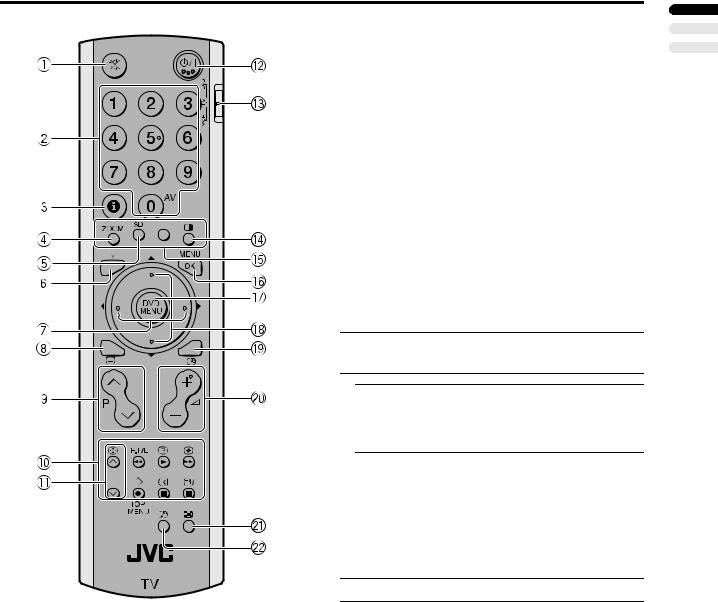
Remote control buttons and functions
1 Muting button
2 Number buttons
3 Information button
4 cbutton
5 3sound button
6 bbutton
7 5buttons
8 g(Text) button
9 ppbuttons
0 VCR/DVD/Teletext control buttons - pbuttons
= Standby button
~ VCR/TV/DVD switch ! Rbutton
@ Colour buttons
# abutton
$ Dbutton % 6buttons
^ fbutton
& rqbuttons * Xbutton
( gbutton
Turn the TV on or off from standby mode
1 Make sure you set the VCR/TV/DVD switch to the TV position.
• You cannot turn the TV on or off when the VCR/TV/ DVD switch is set to the VCR or DVD position.
2 Press the #(standby) button to turn the TV on or off.
When the TV is turned on, the power lamp changes from red to green.
• The power can be turned on by pressing the b button, ppbuttons or Number buttons.
• Check that the AC plugs on the power cords from the TV and receiver are connected to AC outlets.
Choose a TV channel
Use the number buttons:
Enter the programme number (PR) of the channel using the number buttons.
Example:
• PR 6 → press 6
• PR 12 → press 1and 2
Use the ppbuttons:
Press the ppbuttons to choose the programme number (PR) you want.
ENGLISH
13

Remote control buttons and functions
Use the PR LIST: |
Use the PR LIST: |
||
|
|
|
|
|
1 Press the h(information) button to display the |
|
1 Press the h(information) button to display the |
|
PR LIST |
|
PR LIST |
Pressing the h(information) button changes the display as follows:
PR LIST |
|
PR |
ID |
AV |
|
01 |
BBC1 |
02 |
|
03 |
|
04 |
|
05 |
|
06 |
|
07 |
|
08 |
|
09 |
|
TV |
OK |
-10 |
+10 |
D0011-EN |
|
12 : 00
No display
2Press the 5and 6buttons to choose a programme number (PR). Then press the a button
•For programme numbers (PR) with the CHILD LOCK function set, the n(CHILD LOCK) mark appears next to the programme number (PR) in the PR LIST.
•You cannot use the 6buttons to choose a programme number (PR) with the CHILD LOCK function set.
•Even if you try to choose a programme number (PR) with the CHILD LOCK function set, the n(CHILD LOCK) mark will appear, and you cannot watch the TV channel. To watch the TV channel, see “CHILD LOCK” on page 29.
Adjust the volume
Press the rqbuttons to adjust the volume.
The volume indicator appears and the volume changes as you press the rqbuttons.
•The headphone volume is adjusted with the “HEADPHONE” menu (see page 26).
2Press the 5and 6buttons to choose an EXT terminal. Then press the abutton
•The EXT terminals are registered after the programme number PR 99.
•You can choose a video input signal from the S- VIDEO signal (Y/C signal) and regular video signal (composite signal). For details, see “S-IN (S-VIDEO input)” on page 27.
•If you do not have a clear picture or no colour appears, change the colour system manually. See “COLOUR SYSTEM” on page 23.
•This TV set has a function which can automatically change over the input according to a special signal output from an external device. (The EXT-4 and EXT-5 terminals do not support this function.)
To return to a TV channel:
Press the bbutton, the pp buttons or the number buttons.
To use the programme number PR 0 (AV):
When the TV and VCR are connected only by the aerial cable, choosing the programme number PR 0 (AV) allows you to view images from the VCR. Set the VCR RF channel to the programme number PR 0 (AV) manually. For details, see “EDIT/MANUAL” on page 32.
Pressing the obutton changes the choice as follows:
TV mode |
EXT modes |
Programme |
PR 0 |
EXT-1 |
|
EXT-2 |
|
numbers |
|
|
|
or |
|
PR 1 – PR 99 |
|
E1 |
E2 |
S2 |
|
|
|
|
|
EXT-3 |
|
|
|
|
E3 |
or |
S3 |
|
|
EXT-5 |
|
EXT-4 |
|
|
E5 |
or |
S5 |
E4 |
|
Muting the sound
Press the l(muting) button to turn off the sound.
Pressing the l(muting) button again restores the previous volume level.
•The VCR sends its playback image along the aerial cable as an RF (radio frequency) signal.
•Also see your VCR instruction manual.
Watch images from external equipment
Use the obutton:
Press the obutton to choose an EXT terminal.
TV mode |
EXT modes |
Programme numbers PR 1 – PR 99
|
EXT-1 |
|
EXT-2 |
|
|
E1 |
E2 |
or |
S2 |
|
|
|
EXT-3 |
|
|
|
E3 |
or |
S3 |
|
EXT-5 |
|
EXT-4 |
|
E5 |
or |
S5 |
E4 |
|
Use the 6 buttons:
Press the 6 buttons to choose an EXT terminal.
14

Remote control buttons and functions
ZOOM function
You can change the screen size according to the picture aspect ratio. Choose the optimum one from the following ZOOM modes.
AUTO:
When a WSS (Wide Screen Signalling) signal, which shows the aspect ratio of the picture, is included in the broadcast signal or the signal from an external device, the TV automatically changes the ZOOM mode to 16:9 ZOOM mode or FULL mode according to the WSS signal.
If a WSS signal is not included, the picture is displayed in accordance with the ZOOM mode set with the 4:3 AUTO ASPECT function.
•For details of the 4:3 AUTO ASPECT function, see “4:3 AUTO ASPECT” on page 23.
•When the AUTO (WSS) mode does not function
correctly due to poor WSS signal quality or when you want to change the ZOOM mode, press the c button and change to another ZOOM mode.
REGULAR:
Use to view a normal picture (4:3 aspect ratio) as this is its original shape.
PANORAMIC:
This stretches the left and right sides of a normal picture (4:3 aspect ratio) to fill the screen, without making the picture appear unnatural.
• The top and bottom of the picture are slightly cut off.
14:9 ZOOM:
This zooms up the wide picture (14:9 aspect ratio) to the upper and lower limits of the screen.
16:9 ZOOM:
This zooms up the wide picture (16:9 aspect ratio) to the full screen.
16:9 ZOOM SUBTITLE:
This zooms up the wide picture (16:9 aspect ratio) with subtitles to the full screen.
FULL:
This uniformly stretches the left and right sides of a normal picture (4:3 aspect ratio) to fill the wide TV screen.
•For 16:9 aspect ratio pictures that have been squeezed into a normal picture (4:3 aspect ratio), use the FULL mode to restore the picture to its original shape.
Choose the ZOOM mode
1Press the cbutton to display the ZOOM menu
ZOOM
AUTO REGULAR PANORAMIC 14:9 ZOOM 16:9 ZOOM
16:9 ZOOM SUBTITLE FULL
 BACK
BACK
TV OK
D0009-EN
•The cbutton does not work in the twin pictures mode.
2Press the 6buttons to choose a ZOOM mode. Then press the abutton
The picture expands and the chosen ZOOM mode is displayed in about 5 seconds.
•The ZOOM mode may be automatically changed by the control signal from an external device. When you want to return to the previous ZOOM mode, choose the ZOOM mode again.
Adjusting the visible area of the picture
If subtitles or the top (or bottom) of the picture are cut off, you can adjust the visible area of the picture manually.
1Press the cbutton
The ZOOM menu appears.
2Press the abutton to display the ZOOM mode indicator
The indicator appears.
16 : 9 ZOOM
D0010-EN
3While it is displayed, press the 6buttons to change the position of the picture
•You cannot adjust the visible area in REGULAR or FULL mode.
3D SOUND function
You can enjoy sounds with a wider ambience.
Press the 3button to turn the 3D SOUND function on or off
•The 3D SOUND function does not work properly with mono sound.
•The 3D SOUND function can be also turned on or off by using the SOUND SETTING menu. For details, see “3D SOUND” on page 25.
ENGLISH
15
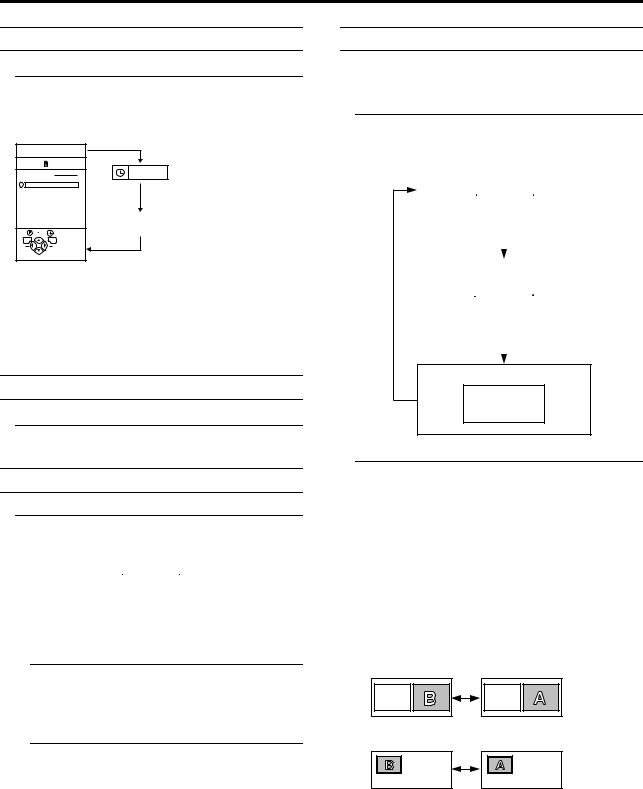
Remote control buttons and functions
Displaying the current time
You can display the current time on the screen.
Press the h(information) button to display the current time
Pressing the h(information) button changes the display as follows:
PR LIST |
|
PR |
ID |
AV |
|
01 |
BBC1 |
02 |
|
03 |
|
04 |
|
05 |
|
06 |
|
07 |
|
08 |
|
09 |
|
TV |
OK |
-10 |
+10 |
D0011-EN |
|
12 : 00
No display
•This TV uses teletext data to set the current time. If the TV has not received a TV channel that has teletext programmes since it was turned on, the time display is blank. To see the time, choose a TV channel that has teletext programmes.
•When watching videos, an incorrect current time is sometimes displayed.
Return to TV channel instantly
You can return to a TV channel instantly.
Press the bbutton
The TV returns to the TV mode and a TV channel appears.
Using the FREEZE function
You can view the current programme as a still picture.
1Press the fbutton
The still picture of the current picture will appear.
current |
|
|
|
|
|
|
|
|
|
still picture |
|
|
|
|
|
|
|
|
|
||
programme |
|
|
|
|
|
|
|
|
|
|
|
|
|
|
|
|
|
|
|
|
|
|
|
D0056 |
||||||||
To cancel the FREEZE function:
Press the fbutton, the pp buttons or the number buttons.
•The FREEZE function does not work while a subpicture is displayed.
•The still picture cannot be output from the TV.
•The FREEZE function is cleared if no operation is performed for approximately one minute.
Using the PIP function
You can view two pictures (Main-picture and sub-picture). Two different TV programmes can be watched at the same time, or a TV programme and a video programme from an external device can be watched at the same time.
1Press the Rbutton
Pressing the Rbutton changes the PIP mode as follows:
|
Twin pictures mode |
||||||||
Main- |
|
|
|
|
|
|
|
|
Sub- |
|
|
|
|
|
|
|
|
||
|
|
|
|
|
|
|
|
||
picture |
|
|
|
|
|
|
|
|
picture |
|
|
|
|
|
|
|
|
|
|
|
|
|
|
|
|
|
|
|
|
|
|
|
|
|
|
|
|
|
|
Picture in picture mode |
|
|||||||||
Main- |
|
|
|
|
|
|
|
|
|
Sub- |
|
|
|
|
|
|
|
|
|
||
|
|
|
|
|
|
|
|
|
||
picture |
|
|
|
|
|
|
|
|
picture |
|
|
|
|
|
|
||||||
|
|
|
|
|
|
|
|
|
|
|
|
|
|
|
|
|
|
|
|
|
|
|
|
|
|
|
|
|
|
|
|
|
Cancel the PIP function
Main-  picture
picture
D0057
2Press the p buttons to change the subpicture to the picture from another EXT terminal
Listening to the sound of the sub-picture:
You can listen to the sound of the sub-picture with the headphones while listening to the sound of the mainpicture from the TV speakers.
For details, see “HEADPHONE” on page 26.
•The sub-picture sound is mono.
Changing the position of the sub-picture:
You can choose one of four positions.
For details, see “PIP (picture-in-picture)” on page 24.
Swapping the main-picture and sub-picture:
Press the gbutton.
The main-picture and sub-picture will be swapped.
A |
B |
A |
B |
D0051
16

Remote control buttons and functions
Cancelling the PIP function:
Press the Rbutton or bbutton.
•If the main-picture signal is poor, the quality of the sub-picture may also be poor.
•If the pictures have different standards, the top and bottom of one of them may be missing.
•If an external device is operated, the sub-picture may disappear. If this happens, press the Rbutton again to redisplay the sub-picture.
•You cannot view a scrambled channel in the subpicture. If the g(swap) button is pressed when viewing a scrambled channel in the main-picture using an external decoder, the channel you have been viewing in the sub-picture will appear in both the main-picture and sub-picture.
•The ZOOM function does not work in the twinpicture mode.
•Do not press the g(swap) button while you are recording the TV output on the VCR. If you do, the TV output signal will change.
•The BLUE BACK function does not work in the twin picture mode or the picture-in-picture mode.
•A progressive-scanning picture cannot be displayed as the sub-picture.
Also:
-When the EXT-4 picture is a progressive-scanning picture, you cannot choose EXT-4 with the p buttons.
-When the EXT-4 picture signal is changed to a progressive-scanning picture while the EXT-4 picture is displayed as the sub-picture, the PIP function is cancelled.
-The pictures cannot be swapped when a progressive-scanning picture from EXT-4 is being displayed as the main picture.
•The sub-picture cannot be output from the TV.
Using the MULTI-PICTURE function
You can display multi-pictures so you can find a program you want to view.
1Press the Xbutton to display multi-pictures
The channels are displayed in channel number order. The multi-pictures will appear in multi-picture mode.
12-pictures multi:








 Still pictures
Still pictures

 Moving picture
Moving picture
D0058-EN
3Press the abutton
The multi-pictures disappear and the chosen picture appears.
Cancelling the multi-pictures:
Press the bbutton, the number buttons or the a button.
•Pictures from external devices cannot be displayed in the 12-pictures multi mode.
Operating a JVC brand VCR or DVD player
These buttons will operate a JVC brand VCR or DVD player. Pressing a button that looks the same as the device’s original remote control button has the same effect as the original remote control.
1Set the VCR/TV/DVD switch to the VCR or DVD position
VCR:
When you are using a VCR, set the switch to the VCR position. You can turn the VCR on or off with the # (Standby) button.
DVD:
When you are using a DVD player, set the switch to the DVD position. You can turn the DVD player on or off with the #(Standby) button.
2Press the VCR/DVD Control Button to control your VCR or DVD player
•If your device is not made by JVC, these buttons will not work.
•Even if your device is made by JVC, some of these buttons may not work, depending on the device you are using.
•You can use the pbuttons to choose a TV channel the VCR will receive, or choose the chapter the DVD player plays back.
•Some models of DVD player use the pbuttons for both operating the fast forward/backward functions and for choosing the chapter. In this case, the 253buttons do not work.
•Set the VCR/TV/DVD switch to the TV position when you turn the TV on or off.
To use Dbutton
Some DVDs allow you to select the disc contents using the menu. When you play back these DVDs, you can select the subtitle language and sound-track language, etc by using the DVD menu.
1Press Dbutton during play back
2Press the pbuttons to choose the screen you want to see
The chosen picture changes to a moving picture.
The DVD menu appears on the screen.
•Press Dbutton again to resume playback at the scene when you pressed the button.
2Press 6or 5buttons to select the desired item
3Press abutton
The menu continues to another screen.
Repeat steps 2 and 3 to set additional items if any.
ENGLISH
17

Teletext function
Basic operation
1Choose a TV channel with a teletext broadcast
2Make sure you set the VCR/TV/DVD switch to the TV position.
3Press g(Text) button to display the teletext
Pressing g(Text) button changes the mode as follows:
TEXT --- |
TEXT --- |
TV mode |
TV and text mode |
|||||
|
|
|
|
|
|
|
|
|
|
|
|
|
|
|
|
TEXT --- |
|
|
|
|
|
|
TEXT --- |
|
|
|
|
|
|
|
|
|
||
|
|
|
Text mode |
|
||
D1043
4Choose a teletext page by pressing the p p buttons, number buttons or colour buttons
To return to the TV mode:
Press the bbutton or g(Text) button.
•If you have trouble receiving teletext broadcasts, consult your local dealer or the teletext station.
•The ZOOM function will not work in the TV and text mode or Text mode.
•You cannot operate menus when viewing a teletext programme.
•Language display depends on the country which was set on the COUNTRY menu. If characters on a Teletext programme do not appear properly, change the COUNTRY Setting to other country’s. For detail, “Changing the COUNTRY setting” on page 36.
When viewing a teletext programme, the text periodically moves a little at a time towards either the top or bottom of the screen. This is to prevent burn-in and is not a malfunction.
Using the List Mode
You can store the numbers of your favourite teletext pages in memory and call them up quickly using the colour buttons.
To store the page numbers:
1Press Bbutton to go into the List mode
The page numbers you have stored are displayed at the bottom of the screen.
2Press a Colour button to choose a position. Then press the Number buttons to enter the page number
3Press and hold down A(Store) button
The four page numbers blink white to show that they are stored in memory.
To call up a stored page:
1Press the Bbutton to engage the List mode
2Press a colour button having a stored page
To exit the List mode:
Press the Bbutton again.
Hold
You can hold a teletext page on the screen for as long as you want, even while several other teletext pages are being received.
Press the C(Hold) button
Hold indication 

To cancel the Hold function:
Press C(Hold) button again.
•The Hold function is cleared if no operation is performed for approximately one minute.
18
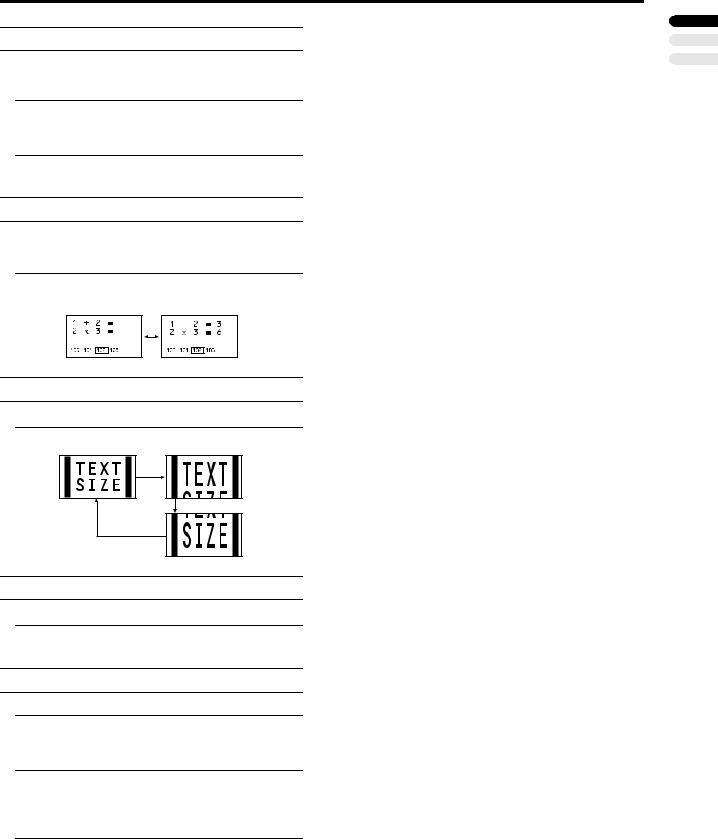
Sub-page
Some teletext pages include sub-pages that are automatically displayed.
You can hold any sub-page, or view it at any time.
1Choose a teletext page that includes sub-pages
Sub-page numbers that can be viewed are automatically displayed at the top of the screen.
2Press the 5buttons to choose a sub-page number
Reveal
Some teletext pages include hidden text (such as the answers to a quiz).
You can display the hidden text.
Each time you press the E(Reveal) button, text is hidden or revealed
Size
You can double the height of the teletext display.
Press the F(Size) button.
Index
You can return to the index page instantly.
Press the G(Index) button
Returns to page 100 or a previously specified page.
Cancel
You can search for a teletext page while watching TV.
1Press the number button to enter a page number, or press a colour button
The TV searches for a teletext page.
2Press the H(Cancel) button
The TV programme appears. When the TV finds the teletext page, its page number appears in the upper left of the screen.
3Press the H(Cancel) button to return to a teletext page when the page number is on the screen
•The TV mode cannot be resumed by pressing the H (Cancel) button. To return to the TV mode press b.
Teletext function
ENGLISH
19
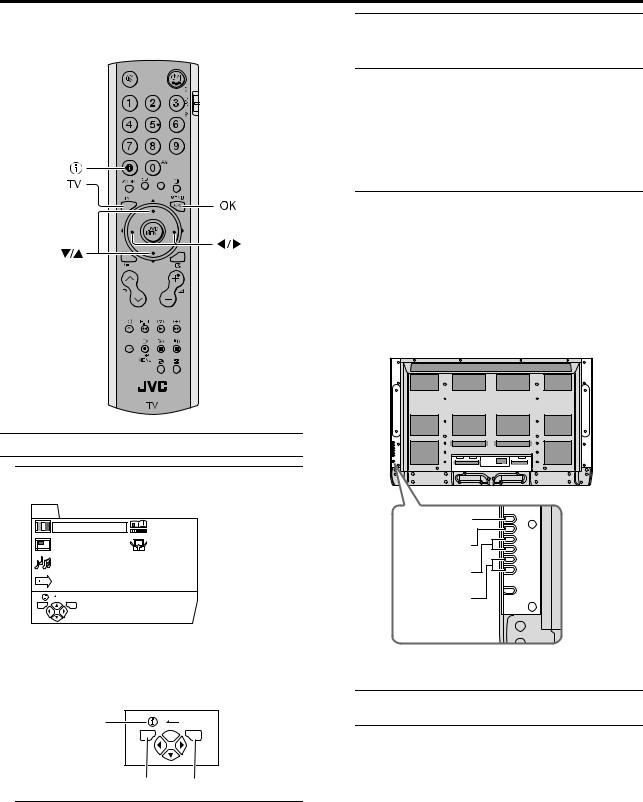
Using the TV’s menu
This TV has a number of functions you can operate using menus. To use all your TV’s functions, you need to understand the basic menu operating techniques fully.
3Press the 6buttons to choose a function
•For details of the functions in the menus, see the following pages.
4Press the 5buttons to choose the setting of that function
•If you want to operate a function which appears only with its name, follow the descriptions of that function on the following pages.
•The display appearing at the bottom of a menu shows you a button on the remote control that you can use when you operate a chosen function.
5Press the abutton to complete the setting
The menu disappears.
•When watching the television with the NTSC system, the menus are displayed at about half of their normal vertical size.
•The menu will disappear if you press the p p buttons while the menu is displayed.
Operation with the buttons on the TV
You can also operate the menus using the buttons on the front panel of the TV.
Basic operation
1Press the abutton to display the MENU (main menu)
MENU |
|
MENU/OK button |
|
|
|
PICTURE SETTING |
FEATURES |
|
PICTURE FEATURES |
INSTALL |
TV/AV button |
SOUND SETTING
6buttons
 EXT SETTING
EXT SETTING
|
BACK |
5buttons |
TV |
OK |
|
D0013-EN |
|
|
•Press the abutton twice while watching the MULTI-PICTURE mode.
•The display appearing at the bottom of a menu shows the buttons on the remote control you can use when you operate a chosen function.
h(Information) button |
BACK |
The menu will disappear after about one minute if no operation is performed.
TV  OK
OK
bbutton abutton
2Press the 5and 6buttons to choose a menu title, and press the abutton
The menu appears.
To return to the previous menu:
Press the h(information) button.
To exit a menu instantly:
Press the bbutton.
20

PICTURE SETTING
Refer to “Using the TV’s menu” (see page 20) for details of displaying the menu.
|
PICTURE SETTING |
|
PICTURE MODE |
BRIGHT |
|
CONTRAST |
|
|
BRIGHT |
|
|
SHARP |
|
|
COLOUR |
|
|
HUE |
|
|
COLOUR TEMP. |
NORMAL |
|
|
BACK |
RESET |
TV |
OK |
|
D0014-EN
PICTURE MODE
You can choose one of three PICTURE MODEs to adjust the picture settings automatically.
BRIGHT:
Heightens contrast and sharpness.
STANDARD:
Standardizes picture adjustment.
SOFT:
Softens contrast and sharpness.
Picture Adjustment
You can change the picture settings of each PICTURE MODE mode as you like.
CONTRAST:
You can adjust the picture contrast.
2: lower
3: higher
BRIGHT:
You can adjust the picture brightness.
2: darker
3: brighter
SHARP:
You can adjust the picture sharpness.
2: softer
3: sharper
COLOUR:
You can adjust the picture colour.
2: lighter
3: deeper
HUE:
You can adjust the picture tint.
2: reddish
3: greenish
•You can change the HUE setting (picture hue) when the colour system is NTSC 3.58, NTSC 4.43 or a signal from the EXT-4 terminal.
However, you cannot do this when the PIP function main picture is set to EXT-4.
To return to the default settings in each PICTURE MODE mode:
Press the blue button.
•This returns the picture settings in the PICTURE MODE mode you have chosen to the default settings, and stores them in the PICTURE MODE mode.
COLOUR TEMP.
You can select one of three COLOUR TEMP. modes (three tones of white) to adjust the white balance of the picture. Since white is the colour which is used as a reference for all the other colours, changing the COLOUR TEMP. mode affects the appearance of all the other colours on the screen.
COOL:
A bluish white. Using this mode when watching bright pictures allows you to enjoy a more vivid and bright picture.
NORMAL:
The normal white colour.
WARM:
A reddish white. Using this mode when watching films allows you to enjoy colours that are characteristic of films.
ENGLISH
21

PICTURE FEATURES
Refer to “Using the TV’s menu” (see page 20) for details of displaying the menu.




 PICTURE FEATURES
PICTURE FEATURES
DIGITAL VNR |
AUTO |
|
Super DigiPure |
AUTO |
|
COLOUR SYSTEM |
|
|
MOVIE THEATRE |
AUTO |
|
4:3 AUTO ASPECT |
|
|
COLOUR MANAGEMENT |
ON |
|
PIP |
|
|
|
BACK |
|
TV |
OK |
|
D1015-EN
DIGITAL VNR
The DIGITAL VNR function cuts down the amount of ‘noise’ (‘snow’ or interference) in the original picture. You can choose from the three DIGITAL VNR function settings of AUTO, MIN and MAX.
AUTO:
The TV will automatically adjust the level of the DIGITAL VNR effect to match the amount of noise in the picture, giving you the best possible picture.
•If you set the DIGITAL VNR effect too high it can make the picture less sharp. It is recommended to use the AUTO setting if you can.
•AUTO cannot be chosen when you are watching the EXT-4 picture.
MIN:
The level of the DIGITAL VNR effect is set to the minimum. If you set the DIGITAL VNR function to AUTO but feel that the sharpness of the original picture has not been reproduced fully, change the setting from AUTO to MIN.
•The MIN setting is not suitable for low-quality pictures which contain a lot of noise.
MAX:
The level of the DIGITAL VNR effect is set to the maximum. If you set the DIGITAL VNR function to AUTO but still notice some noise, change the setting from AUTO to MAX.
•The MAX setting is not suitable for high-quality pictures which contain very little noise.
•When a progressive-scanning picture is being displayed, “DIGITAL VNR” cannot be selected.
•The DIGITAL VNR function does not work for progressive-scanning pictures.
Super DigiPure
The Super DigiPure function uses the latest in digital technology to give you a natural-looking picture. The Super DigiPure function includes the following two functions.
DigiPure function:
This function helps to create a natural-looking picture by eliminating unnecessary edges from high-contrast and crisp images. For images with low-contrast, edges are added to produce a sharper, more detailed picture.
You can choose from the three DigiPure function settings of AUTO, MIN and MAX.
•If you set the DigiPure effect too high on a low-quality picture that contains a lot of noise, this may actually make the noise worse. We recommend you use the AUTO setting if you can.
Picture motion compensation function:
This function displays fast-moving pictures (for example, the players or ball in a football game) more smoothly and naturally on the screen.
•The effect level of the picture motion compensation function cannot be changed. The effect level is the same no matter which of the AUTO, MIN or MAX settings is used.
1Choose Super DigiPure
2Press the 5buttons to choose a setting. Then press the abutton
AUTO:
The TV will automatically adjust the level of the DigiPure effect to match the amount of noise in the picture, giving the best possible picture.
•AUTO cannot be chosen when you are watching the EXT-4 picture.
MIN:
The level of DigiPure effect is set to the minimum. When you set the Super DigiPure function to AUTO and notice some noise, change the setting from AUTO to MIN.
•The MIN setting is not suitable for high-quality pictures which contain very little noise.
MAX:
The level of DigiPure effect is set to the maximum. If you set the Super DigiPure function to AUTO but feel that the original picture quality has not been reproduced fully, change the setting from AUTO to MAX.
•The MAX setting is not suitable for low-quality pictures which contain a lot of noise.
OFF:
The Super DigiPure function is turned off.
22

PICTURE FEATURES
COLOUR SYSTEM
The colour system is chosen automatically. However, if the picture is not clear or no colour appears, choose the colour system manually.
1Choose COLOUR SYSTEM. Then press the a button
The sub-menu of the COLOUR SYSTEM function appears.
COLOUR SYSTEM
MAIN |
SUB |
MOVIE THEATRE
The MOVIE THEATRE function displays a cinema film picture more smoothly and naturally on the screen.
AUTO:
The television automatically recognizes the type of signal and turns the function on and off.
ON:
This function is turned on.
OFF:
This function is turned off.
PAL AUTO
 BACK
BACK
TV OK
D0016-EN
2Press the 5buttons to choose MAIN or SUB
MAIN:
You can change the colour system of the main-picture.
SUB:
You can change the colour system of the sub-picture.
•Choose MAIN when a sub-picture is not displayed.
3Press the 6buttons to choose the appropriate colour system. Then press the a button
PAL:
PAL system
SECAM:
SECAM system
NTSC 3.58:
NTSC 3.58 MHz system
NTSC 4.43:
NTSC 4.43 MHz system
AUTO:
This function detects a colour system from the input signal. You can only use this when you are viewing a picture from programme number PR 0 (AV), or an EXT terminal.
•The AUTO function may not function properly if you have poor signal quality. If the picture is abnormal in the AUTO function, choose another colour system manually.
•When in the programme numbers PR 0 (AV) to PR 99, you cannot choose NTSC 3.58 or NTSC 4.43.
SECAM cannot be chosen when the COUNTRY setting is UNITED KINGDOM.
•The motion may appear unnatural when viewing images with the NTSC colour system. When the MOVIE THEATRE function is set to AUTO or ON, the motion may appear unnatural when viewing images with the NTSC colour system.
•You cannot select this function in the twin pictures mode or the picture in picture mode.
4:3 AUTO ASPECT
You can choose one of three ZOOM modes, REGULAR, PANORAMIC or 14:9 ZOOM, as the ZOOM mode for the normal picture (4:3 aspect ratio).
1Choose 4:3 AUTO ASPECT then press the a button
4:3 AUTO ASPECT
PANORAMIC REGULAR 14:9 ZOOM
 BACK
BACK
TV OK
D0017-EN
2Press the 6buttons to choose a ZOOM mode. Then press the abutton
COLOUR MANAGEMENT
This TV supports the COLOUR MANAGEMENT function to ensure dull colours are compensated to produce natural hues.
The COLOUR MANAGEMENT function is on by default.
ON:
COLOUR MANAGEMENT function is turned on.
OFF:
COLOUR MANAGEMENT function is turned off.
• Set this function to ON under normal conditions.
ENGLISH
23

PICTURE FEATURES
PIP (picture-in-picture)
You can choose one of four positions for the sub-picture.
1Press the 6buttons to choose PIP. Then press the abutton
The PIP menu appears.
PIP
 BACK
BACK
TV OK
D0061-EN
2Press the 5buttons to choose the position. Then press the abutton
24

SOUND SETTING
Refer to “Using the TV’s menu” (see page 20) for details of displaying the menu.
SOUND SETTING |
|
|
STEREO/ |
|
|
BASS |
|
|
TREBLE |
|
|
BALANCE |
|
|
SPEAKER |
ON |
OFF |
BBE |
ON |
OFF |
3D SOUND |
ON |
OFF |
A.H.B. |
ON |
OFF |
HEADPHONE |
|
|
SPEAKER
You can turn off the sound from the TV speakers; but you should only do this if an audio system is connected to the TV as a substitute for the TV speakers.
ON:
The TV speakers issue sound.
TV OK |
OFF: |
BACK |
|
|
The TV speakers does not issue sound. |
D0019-EN |
|
STEREO / I • II
When you are viewing a bilingual broadcast programme, you can choose the sound from Bilingual I (Sub I) or Bilingual II (Sub II). If you have poor reception on a stereo broadcast, you can change from stereo to mono sound so that you can hear the broadcast more clearly and easily.
s: Stereo sound v : mono sound
t: Bilingual I (sub I)
u: Bilingual II (sub II)
•The sound mode you can choose differs depending on the TV programme.
•This function does not work in the EXT modes. And this function does not appear in the SOUND SETTING menu.
Sound Adjustment
You can adjust the sound to your liking.
BASS:
You can adjust the low tone of the sound.
2: weaker
3: strong
TREBLE:
You can adjust the high tone of the sound.
2: weaker
3: strong
BALANCE:
You can adjust the volume balance between the left and right speaker.
2: turn the left speaker’s volume level up.
3: turn the right speaker’s volume level up.
BBE
You can use the BBE function to enjoy easy-to-listen sound that is faithful to the original sound recorded.
ON:
This function is turned on.
OFF:
This function is turned off.
•Licensed by BBE Sound, Inc. BBE is a registered trademark of BBE Sound, Inc.
3D SOUND
You can enjoy Surround sound with a “live” effect by using the 3D SOUND function.
ON:
3D SOUND function is turned on.
OFF:
3D SOUND function is turned off.
A.H.B. (Active Hyper Bass)
Used when you want to emphasize the bass sound.
ON:
This function is turned on.
OFF:
This function is turned off.
ENGLISH
25

SOUND SETTING
HEADPHONE
You need to use the HEADPHONE menu to adjust the volume of the headphones.
The HEADPHONE menu can also be used to set whether or not sound comes from the TV speakers when the headphones are being used and to perform the settings for the sound coming from the headphones.
1Press the 6buttons to choose HEADPHONE. Then press the abutton
The sub-menu of the HEADPHONE function appears.
D0044-EN
2Press the 6buttons to choose a function. Then press the 5buttons to change the setting
VOLUME:
You can change the volume of the headphones.
TV SPEAKER:
You can turn the TV’s speakers on or off.
ON:
The sound comes from the TV’s speakers when using the headphones.
OFF:
The sound does not come from the TV’s speakers when using the headphones.
OUTPUT:
You can choose the sound output to the headphones.
MAIN:
You can listen to the sound of the main-picture with your headphones.
SUB:
You can listen to the sound of the sub-picture with your headphones.
•When the sub-picture is a television programme, the sound becomes monaural.
3Press the abutton
Hint:
When a sub-picture is displayed, the sound of the subpicture can be listened to with the headphones while listening to the sound of the main-picture with the TV speakers. To do this, set TV SPEAKER to ON and OUTPUT to SUB.
•Headphones do not work with sound adjusted for BASS and TREBLE, BBE effect sound, A.H.B. effect sound, and 3D SOUND effect sound.
26
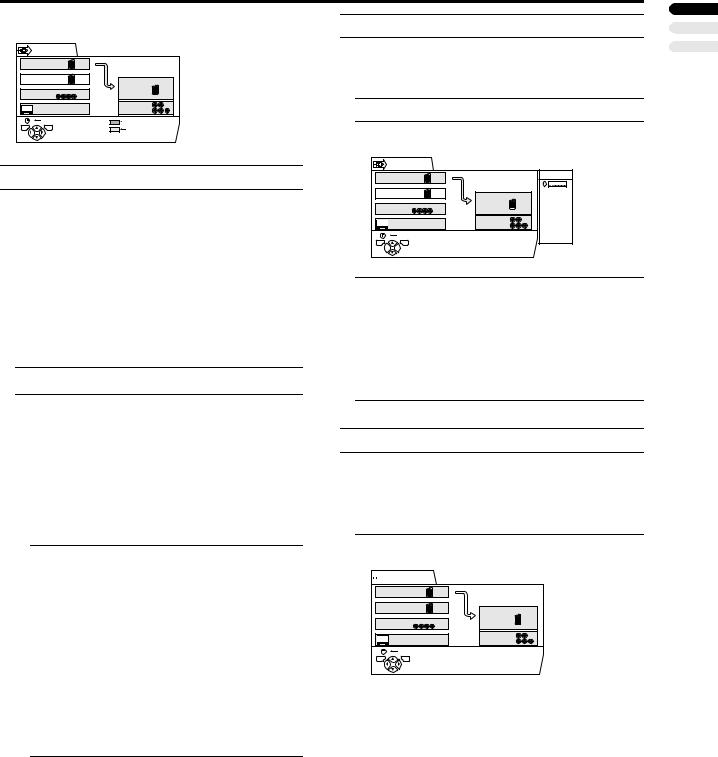
EXT SETTING
Refer to “Using the TV’s menu” (see page 20) for details of displaying the menu.
|
EXT SETTING |
|
|
EXT-1 |
|
|
EXT-3 |
DUBBING |
|
|
EXT-2 |
|
EXT-5 |
|
|
TV |
EXT-4 |
|
BACK |
ID LIST |
TV |
OK |
S-IN |
|
|
|
D0020-EN |
|
|
S-IN (S-VIDEO input)
You can connect a device (such as an S-VHS VCR) to enjoy the high-quality picture of the S-VIDEO signal (Y/C signal).
Preparation:
•First read the device’s instruction manual and “Additional preparation” on page 37 to connect the device to the TV properly. Second, follow the device’s instruction manual to set the device so that it sends an S-VIDEO signal (Y/C signal) to the TV.
•Do not set S-IN (S-VIDEO input) to the EXT terminal connected to a device which cannot output an S-VIDEO (Y/C signal). If it is set wrongly, a picture cannot appear.
1Choose an EXT terminal
2Press the yellow button and set the S-IN (S- VIDEO input).
Then press the abutton
An S-IN (S-VIDEO input) mark is displayed. You can view an S-VIDEO signal (Y/C signal) instead of the regular video signal (composite signal).
To cancel the S-IN (S-VIDEO input) setting:
Press the yellow button and turn off S-IN (S-VIDEO input) mark. The regular video signal (composite signal) pictures are resumed.
•The EXT-1 terminal does not support S-VIDEO signal (Y/C signal) and you cannot set S-IN (S- VIDEO input) in the EXT-1 terminal.
•Setting S-IN (S-VIDEO input) changes the head character from “E” to “S”. When an EXT terminal receives a normal video signal, “E2”, “E3” or “E5” appears on the display. This changes to “S2”, “S3” or “S5” when it receives an S-VIDEO signal.
•Even a device which can output an
S-VIDEO signal (Y/C signal) may output a regular video signal (composite signal) depending on the device setting. If a picture cannot appear because the S-IN (S-VIDEO input) setting has been made, read the device instruction manual carefully again to check for the device settings.
ID LIST
You can have a name corresponding to the devices connected for each EXT terminal. Giving a name to an EXT terminal makes the EXT terminal number appear on the screen, together with the name.
1Choose an EXT terminal
2Press the blue button to display the name list (ID LIST)
|
EXT SETTING |
|
|
|
EXT-1 |
|
ID LIST |
|
EXT-3 |
DUBBING |
VHS |
|
|
EXT-2 |
S-VHS |
|
|
|
DVC |
|
EXT-5 |
|
SAT |
|
|
|
STB |
|
|
EXT-4 |
GAME |
|
TV |
LD |
|
|
|
|
DVD |
|
BACK |
|
8mm |
|
|
Hi-8 |
|
TV |
OK |
|
|
D0021-EN
3Press the 6buttons to choose a name. Then press the abutton
The ID LIST disappears and the name is assigned to the EXT terminal.
•You cannot assign an EXT terminal name not found in the name list (ID LIST).
To erase a name assigned to the EXT terminal:
Choose a blank space.
4 Press the abutton to complete the setting
DUBBING
You can choose a signal source to be output from the EXT- 2 terminal.
You can do this with the output signals of the devices connected to other EXT terminals, or with the picture and sound from a TV channel you are currently viewing.
1Press the 5buttons to choose the arrow from the menu
 EXT SETTING
EXT SETTING
EXT-1
|
EXT-3 |
DUBBING |
|
|
EXT-2 |
|
EXT-5 |
|
|
TV |
EXT-4 |
|
|
|
|
BACK |
|
TV |
OK |
|
D0022-EN
ENGLISH
27

EXT SETTING
2Press the 6buttons to choose an EXT terminal or TV.
Then press the abutton
The arrow in the menu represents a signal flow. The left side of the arrow shows a signal source output from the EXT-2 terminal.
EXT-1/EXT-3/EXT-5:
The output signal of the device connected to an EXT terminal passes through the TV and is output from the EXT-2 terminal.
TV:
The picture and sound of the TV channel you are currently viewing are output from the EXT-2 terminal.
•During dubbing, you cannot turn off the TV. Turning off the TV also turns off the output from the EXT-2 terminal.
•When you choose an EXT terminal as an output, you can view a TV programme or a picture from the other EXT terminal while dubbing the picture from a device connected to the EXT terminal onto a VCR connected to the EXT-2 terminal.
•The RGB signals from the TV games cannot be output. Teletext programmes cannot be output.
28
